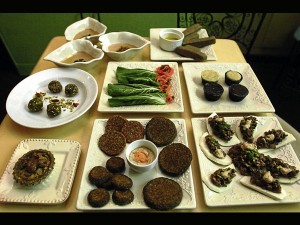
All raw?
Well, yes. I had them all yesterday, and still don’t know what to make of the experience.
Overall, the tasting turned out so much better than I expected. In fact, the sisig, mushroom soup, green shawarma and burger (made from seeds and hemp, sandwiched between lettuce, eaten with tomatoes and onions, served with a delicious capsicum dressing and almond mayonnaise) were excellent; so much so that I really look forward to having them again.
The other offerings were too hard-core, too healthy so that at some point, I felt I was a parrot eating all these nutri-packed seeds.
So what is raw food all about? What are its benefits and who is this budding chef, inviting us to indulge in a bite of sunshine?
Meet Asha Peri, a recently certified raw vegan chef from Bali, Indonesia. She trained under the mentorship of Elaina Love of Pure Joy Planet.
Her mission is “to promote a lifestyle that champions a plant-based diet that gives love and light to the mind, body and spirit” and, while doing so, create a greener planet.
Asha said that 10 years ago, “I made a commitment to live a life of wellness and wholeness.”
She said she was very sickly as a child, suffering from “a very low immune system, a weak liver, a kidney problem and a very unstable, depressed emotional life.”
But all that has changed, especially after she turned raw vegan last year. Peri is now a refreshing ray of sunshine with so much passion and positive energy. In fact, I told her that the best part of her food “is you!”
A raw food chef is one who “keeps all ingredients at their freshest and most natural state.”
The raw food chef, she said, is “a conduit to transmit the sun’s energy (considered as ‘the most important nutrient’) into the food that she prepares for others to experience incredible lightness and for them to feel more vibrantly alive.”
Since it’s a plant-based diet, she said, the ingredients of a raw diet “encompass the use of all plant parts, particularly the leaves, which contain the most sun energy manifested in what we know as chlorophyll, but the other plant parts are also used with various raw ingredients to enhance it.
“It uses all kinds of fruits and vegetables,” Asha added, “including fungi and seaweed, sprouted nuts, seeds and grains, healthy fats, super foods as the main ingredients, with the help of natural and raw sweeteners, thickeners, spices and condiments to help transforms a bland vegetable to a highly flavorful one.”
Peri enumerated the advantages of eating raw food. She explained that it is:
Packed with enzymes that help the food digest itself, instead of the person using up the enzymes in the body to digest the food; thus, the body is able to focus more on healing and repairing the cells, promoting longevity and a disease-free life;
Nutrient-dense, packed with essential vitamins, minerals, protein, readily absorbed by the body;
“Life-promoting,” as it increases longevity. Heating food at a high temperature (beyond 105 degrees) changes the molecular structure of the food and alters the supposed benefits one can get from it;
Gives one a feeling of lightness and a clarity, making one feel more deeply connected with every living thing on the planet;
Easy to digest and has lots of fiber that assist in regular elimination, thus promoting colon health. It also has a detoxifying effect in the body;
Naturally sweet. Raw food has a fresh and naturally sweet taste that is low-glycemic, which does not raise up blood sugar levels like how a lot of regular sweeteners do;
Alkaline-based. Most fruits and veggies are alkaline, which makes the environment of the body more oxygenated;
Has lower calories and high in fiber. One will naturally lose weight without having to diet hard.
When preparing raw food, according to Peri, it is best to remember to:
Use organic produce for more minerals;
Use an ozonator, or soak ingredients in tepid vinegar with water for 20 minutes. Wash hands before handling food. Store ingredients in air-tight containers to prevent oxidation and to prevent molds from growing;
Use seasonal and ripe produce, they have more nutrients, having reached their full ripening stage. It also lessens our carbon footprint;
Be creative and positive. “The raw food chef is an instrument of sun energy being transmitted to those who partake of the food, the process will only happen if the chef puts her full presence and positive energy in what she’s doing during the whole preparation.”
Raw mushroom soup
A raw cuisine staple is mushroom soup.
Ingredients:
3 c coconut milk (or any nut milk)
10 shitake mushrooms, sliced thinly and marinated in tamari, lime and honey for 30 minutes (save two mushrooms for garnish)
2 medium bell peppers
1 tbsp honey
1 tbsp tamari soy sauce
1 tsp salt
1 tsp garlic powder
1 tsp onion powder
1/8 tsp cayenne pepper
1 tsp dried basil leaves
½ tbsp nutritional yeast seasoning
2 tsp psyllium husk (to be added at the end of blending to thicken the soup)
Blend all ingredients until smooth except for the psyllium husk.
Season to taste.
Add the psyllium husk and blend for a few seconds to thicken it.
Asha Peri does raw food catering and this Saturday. She will be conducting a Raw Food Seminar at Sugar Leaf. Call her at 0917-8611212, or Angelo Songco at 0917-8039055.
E-mail the author at raspiras@inquirer.com.ph.